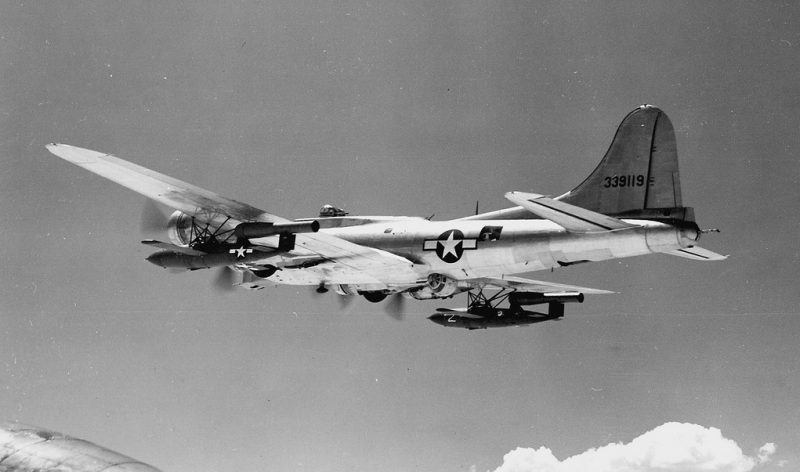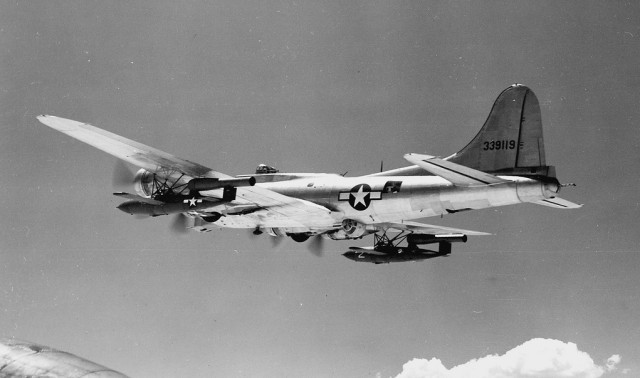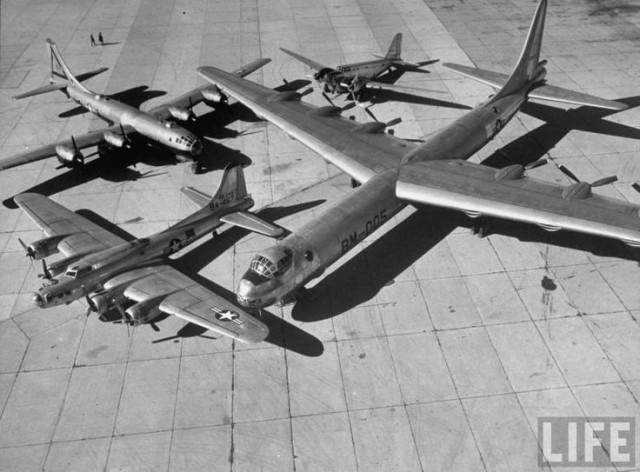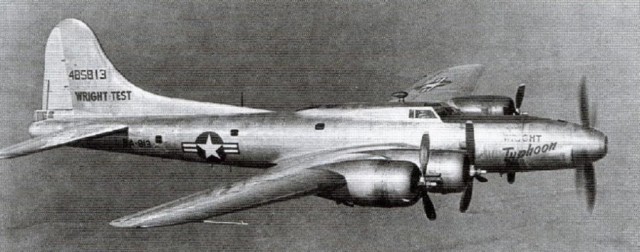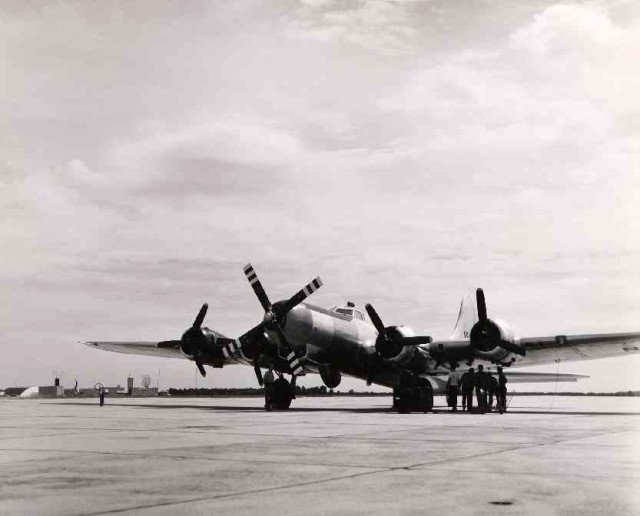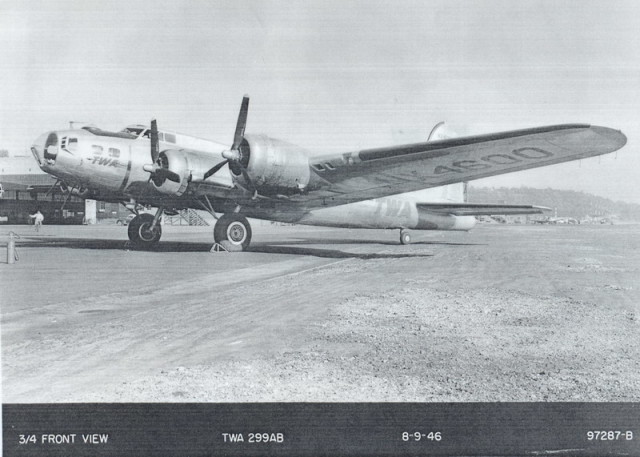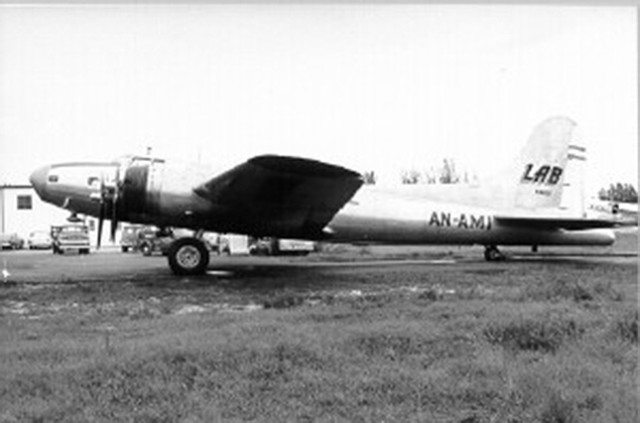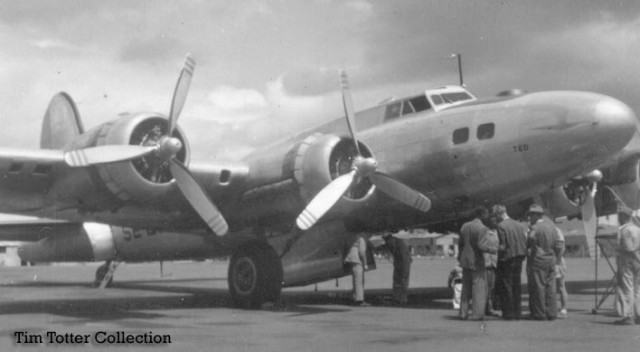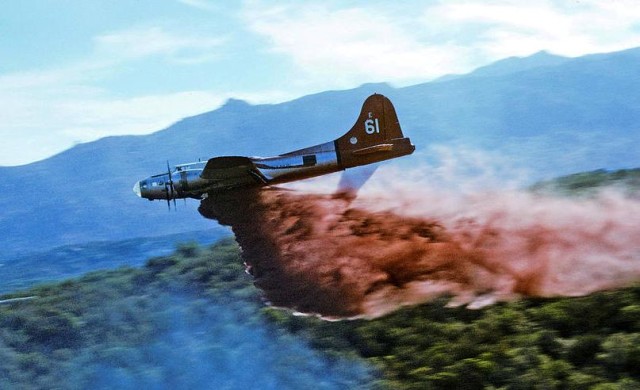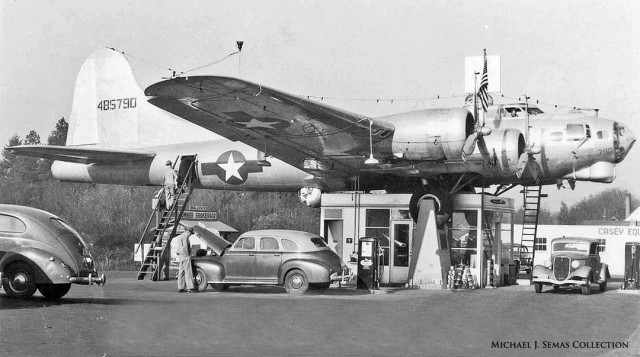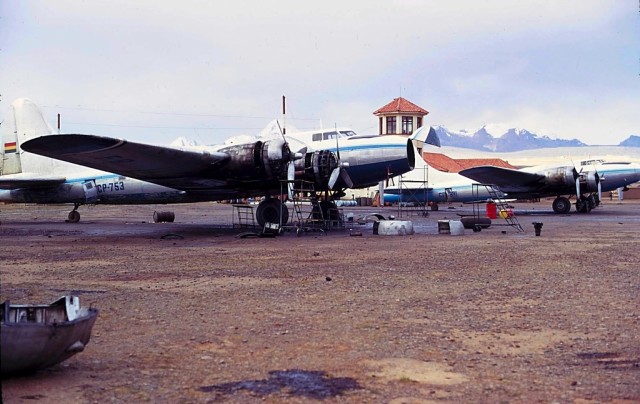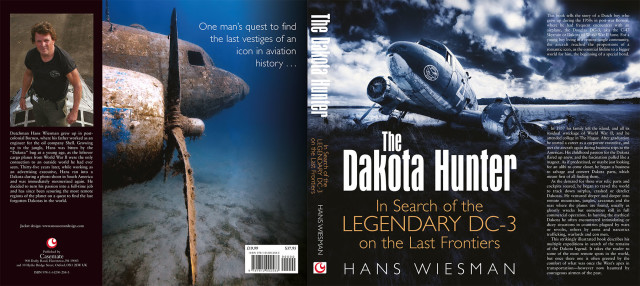This Dakota Hunter Blog is about post-war tests with US built copies of the Nazi V-1 Buzz Bomb from a B-17 Flying Fortress plus loads of odd photos of that legendary Bomber.
The Pulse Jet propelled JB-2 ( Jet-Bomb) “Loon” aka V-1 was built by Republic, Jeep and Ford. They were also launched from foldable ramps since 1944 and even from a submarine. Intended for massive application in the case of an invasion of Japan’s Homeland, their operational use never materialized.
In post-war experiments, the JB -2 became the testbed and forerunner of the first US made Cruise missile, the Martin MGM-1 Matador.
Photo above; This picture reflects the dramatic leap forward in Aviation Technology that took place between 1935 and 1947. The Medium Bomber Douglas B-18 Bolo in the backdrop with a fuselage length based on theDC-2/ DC-3 concept is dwarfed by the B-17 Flying Fortress in the left front. Despite its obsolescence at the start of the war, the B-18 Bolo was the most numerous bomber in service with the Air Corps! The Military were eagerly waiting for the better performance and payload of the B-17/ B-24. But the B-29 Super Fortress (at upper left) and the B-36 Peacemaker (its maiden flight took place in mid-1946) give evidence of the mind-boggling progress that followed suit, in a time span of 12 years only. The wing span, the fuselage dimensions, their payload seemed almost to have doubled with every new model that emerged 3/4 years later. It was in an environment of a determined US Military Industrial complex in cooperation with Top ranking Universities and the Federal Agency NACA, that under the pressure of a war with overseas enemies this phenomenon could take place. With such overwhelming results that it ranked the USAF as the world leader in aviation technology. Bravo and so sorry for the B-17: in spite of all its upgrades to the G-model, the aircraft was definitely outdated by 1945 for a post-war strategic role in the USAAF. But in many other Air Forces ( Argentina, Brazil, Canada, France, South Africa etc) the B-17 would soldier on for many more years after 1945.
The Boeing B-17 Flying Fortress made its Maiden Flight in July 1935, in the same year as the Douglas DC-3and featured basically the same engines: Wright Cyclones R-1820’s. Operational since 1938, this heavy bomber was to become one of the American “Icons of Victory” of WW II, along with other types as the C-47/ Dakota, the Mustang, the B-24, B-25 and so many others. With a total production from 1936- 1945 of 12.730 aircraft of all its types B-17 A to the final version B-17 G, it was arguably one of the most successful Heavy Bombers of the war. Contrary to popular belief, it’s ‘rival’, the Consolidated B-24 Liberator, came to a whopping 18.000 aircraft produced by the end of the war, the highest number of any allied aircraft type produced. The legendary tales of the B-17 returning home from missions with extensive battle damage, it is this reputation that made the aircraft enter the Hall of Eternal Fame. But its career as a strategic long distance bomber in the USAAF was taken over by the more modern Mega bombers that emerged by the end of the war from the Pacific war theater.
The B-17 remained in limited services with USAAF, Navy and US Coast Guard, its role relegated to being flown as a Transport, Photo recce, Long Distance patrol aircraft with Search & Rescue, but also as a remote controlled drone and in experiments with new weapons or engines (see feature photo with JB-2 Loon). And below, as a test bed for the new Wright Typhoon T-35 Turbo Prop and the P & W T-34 engine which were since 1945 under development. Those were huge engines, bigger and heavier than the biggest existing Piston Radial R- 4360! This first generation of Axial Flow Gas Turbine engines aka Turbo Props was considered to be the only option for the propulsion of big aircraft, to replace the intricate Radial Piston Prop engines: with 2/4 banks of 7 cylinders and turbo compounds, this engine was a maintenance nightmare and often prone to overheating and subsequent engine fires in its very tight fitting streamlined cowlings.
Photo above shows all 4 Props of the B-17 feathered, the aircraft flies on a single experimental Wright XT-35 Turbo Prop engine of some 5000 hp. That was more than the combined 4 Wright Cyclones R-1820 could produce. In 1946, first designs for the new long distance bomber XB-52 started and in May 1948, the USAF was still saying “the T-35 was imperative for the B-52”!. It would all take another direction as we know now ( more news on the development of the B-52 in my next blog, stay tuned).
Photo above shows a B-17 with a Turbo Prop and huge frontal airscrew of the Pratt & Whitney’s T-34 Turbo Wasp. (Photo taken in September 1950). The first application for the T-34 was the Boeing YC-97J Stratofreighter, a turbo prop converted C-97 which later became the Aero Spacelines Super Guppy. The next application for this turbo prop engine was the Douglas C-133 Cargomaster. In the early 1950’s Lockheed tried to extend the future life cycle of its successful Super Constellation with a conversion to the P & W YT-34 P Turbo Props, each rated at 5500 bhp. Those were replacing the usual radial piston engines Wright R-3350 Duplex -Cyclones. The new aircraft was designated R7V-2, and first flew on 1 September 1954. The R7V-2 reached 412 mph (663.05 km/h) making it the fastest transport aircraft in the world at the time. The two R7V-2 aircraft were delivered to the Navy the same year but it never came to any new orders. Its further development was overshadowed by the rapid progress of the pure Jet engine with a new generation of passenger jetliners as the Boeing B-707 and the Douglas DC-8. Lockheed fought against a more advanced competition and lost a major share in the commercial airliner market.
Photo above shows one of the few B-17’s that extended its post-war career as a commercial passenger airliner. Trans World Airlines had the B17G 44-85728 converted to executive use for development of new route structures on TWA’s foreign runs. Boeing was hired to rebuild the Fortress at their Seattle facility, which the company saw as a opportunity to explore the post-war market for similar Fortress conversions. Boeing Model 299AB came out and obtained the registration of NX4600 for the aircraft after it was purchased in June 1946. Once the modifications were completed, TWA deployed NX4600 to the Middle East and used it to transport TWA executives. The cabin entrance and comfort remained very basic, far below that of any standard DC-3/ Dakota, but the aircraft offered an unusual flight range for that era. This same Fortress was transferred to the Shah of Iran in April 1947. The airplane eventually ended up operating for a French survey company (Reg nr F-BGOE, scrapped in France during the 1970s). A few surplus B-17s were converted into cargo transports with XC-108A-type cargo doors installed. (photo and info courtesy twaseniorsclub.org)
Photo above. In South America operated a small number of B-17’s converted to Cargo or Passenger transport. One of them had the Nicaraguan registration AN-AMI and markings for “Linea Aerea Borinquen” -LAB- implying Puerto Rican ownership. Interestingly, according to Gary Kuhn, ” that same registration was in fact assigned to a Douglas DC-6 cargo plane from LANICA, the Nicaraguan national airline, just about the same period of time. Was LAB one of the “proprietary” airlines operated by the CIA in the Caribbean? Was it a legitimate airline, with regularly scheduled flights? A Charter? What happened to this airplane? Is it still extant? Was it really destroyed?”
In his interesting report, it surfaces that this airplane has played a role in a number of stealthy operations, involving Nicaragua’s President Somoza, a coup in 1959 against the Venezuelan President and most probably a final flight to Cuba, in the first year of Castro’s take over. The CIA was deeply involved in all of those ( counter) coups of that era, therefore, a link between AN-AMI and CIA operations seems most probable.
Photo above depicts another Civilian B-17 (SE-BAN) with another remarkable history. The aircraft was delivered to USAAF as 42-3490 in July 11, 1943.
Damaged during a bombing raid on Berlin, Over Germany three engines had been knocked out by flack. Captain Tim Totter and crew managed to make it to Bulltofta airfield near Malmö, Sweden. The crew was interned till November 1944. The bomber was then repaired and taken to Stockholm and traded to the Swedish government along with eight other B-17’s for $1 (Big Deal!) and the release of American airmen interned in Sweden. Saab then converted the aircraft to an airliner (SE-BAN) which was in service till 1948. At some point later it was scrapped. Parts of 42-3490 are stored at the Arlanda Flight Museum in Stockholm. (Thanks to Wikipedia and the Tim Totter Collection via www.warbirdregistry.org)
Photo above (courtesy Bill Gabbert) depicts the spectacular low fly pass of the B-17 in its role a fire-fighting aircraft. Several ex-military B-17s were fitted with extra tanks and were used for spraying operations. In 1960, the first of 23 ex-military B-17Fs and Gs were converted into fire-fighting aircraft. In the bomb bay a 2000-gallon tank was installed which carried a water-borate mixture for a more efficient forest fire fighting. These planes were operated under contract to the US Forest Service, and a few were still flying as late as 1984. By the early 1980s, most B-17 water bombers had been grounded, mainly due to the lack of Wright R-1820 Cyclone engines. One water-bomber operator solved this problem by installing Rolls-Royce Dart turboprop engines in place of the Cyclones. This was done for B-17G Air Tanker N134ON. The aircraft crashed in October of 1970 when fire smoke caused engine failure in the Dart turboprops. The Institut Geographique National of France operated thirteen B-17s during the post-war years to perform worldwide survey and geophysical research missions.
Photo above of a B-17 “Gate Guard” was taken in Portland, Oregon. A man named Art Lacy, he had a birthday party in 1947 and bet a friend five dollars that he was going to put a B-17 Flying Fortress WWII surplus bomber on top of his gasoline station. After cleverly overcoming tons of hurdles he was able to move the flying machine to his gas station, located south of the Portland in Milwaukie, Oregon. It served as an attention-getter for almost 64 years. (The image is courtesy of the M. J. Semas Collection published in The Old Motor, a vintage automobile online Mag).
Photo above and below depict the very last commercially operated B-17’s of this world. Location was El Alto Airport, La Paz, Bolivia at 13.300 feet altitude the highest International Airport worldwide (over 4.000 meters!). The aircraft were operated by Frigorifico Reyes. Fri Reyes was the largest meat haulers company in Bolivia. They started flying since the 1960s and became famous for flying the last civil Boeing B-17s across the Andean mountains. After the B-17s were sold to the US, Fri Reyes purchased eight Convair 240s from surplus US stocks. Then in the late 1970s several DC-4s where bought to supplement the fleet. In 1981 Fri-Reyes acquired all surviving piston aircraft from Faucett in Peru, namely two DC-4s and two DC-6s. By early 1990s, its fleet had been reduced to just a few aircraft, due to many accidents and dwindling business. Seen here are CP-753 and sister ship CP-891 in the backdrop. (Information courtesy Michael Prophet, photos courtesy Ron Mak)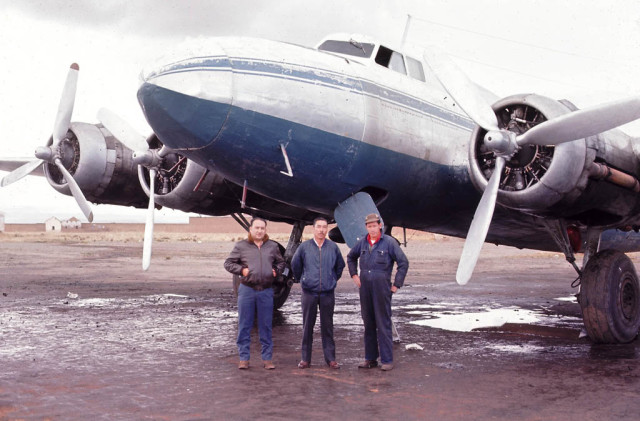
Photo above (courtesy Michael Prophet): B-17E CP-753 El Tigre first arrived in Bolivia in July 1964 with Compania Boliviana de Aviacion. Previous operators include Lysdale Flying Service and Canadian Kenting Aviation. She was involved in several mishaps, such as a port undercarriage collapsed while taxiing at La Paz (1974) and a crash at while landing at San Borja (1976). She was rebuilt Bolivian Style with a few scars and wrinkles left. Sister ship was B-17G CP-891 ex CP-627. This aircraft was saved and brought back to the US (1981) and can be seen as a static display at March AFB museum CA. Later, the CP-753 was sold and delivered from Bolivia to Ft. Lauderdale, March 1990 and continued its career as N8WJ with World Jet Inc, Fort Lauderdale, FL, March 1990-1991. She ended up in a restoration process from 1990-1998 and finally landed in the Paul Allen/ Flying Heritage Collection, Everett, WA.
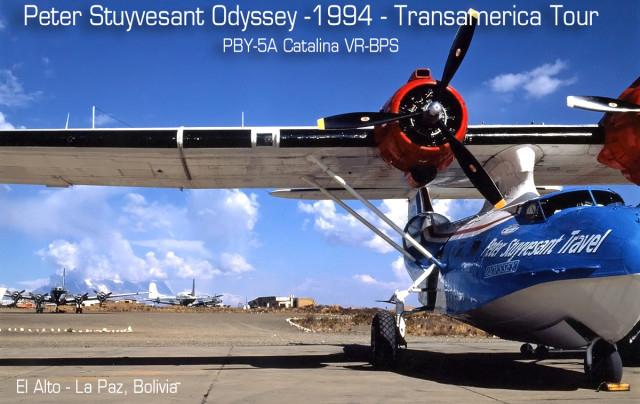 Photo above: First time I came to Bolivia was in 1994. We made a visit to El Alto Airport in the Plane Sailing Catalina PBY-5A flown by Paul Warren Wilson from the UK. We were told to park in the Zombie Area of that weird Airport. Hidden far away from the International Jetliners, there was a “ghost town” of the old abandoned airport passengers building and dilapidated sheds, that were now filled with aircraft parts of vintage propliners of the 1940’s/ 1950’s. Some of the aircraft were still in operation (C-46 Commandos and Convairs) but most were languishing derelicts, in a sorry state of decay ( DC-3, DC4, DC-6’s). If you would like to receive my next blog about the Catalina Odyssey and other vintage Aviation subjects, stay tuned and subscribe with your name in the white bar right under the last photo.
Photo above: First time I came to Bolivia was in 1994. We made a visit to El Alto Airport in the Plane Sailing Catalina PBY-5A flown by Paul Warren Wilson from the UK. We were told to park in the Zombie Area of that weird Airport. Hidden far away from the International Jetliners, there was a “ghost town” of the old abandoned airport passengers building and dilapidated sheds, that were now filled with aircraft parts of vintage propliners of the 1940’s/ 1950’s. Some of the aircraft were still in operation (C-46 Commandos and Convairs) but most were languishing derelicts, in a sorry state of decay ( DC-3, DC4, DC-6’s). If you would like to receive my next blog about the Catalina Odyssey and other vintage Aviation subjects, stay tuned and subscribe with your name in the white bar right under the last photo.
Later, I came back many times as The Dakota Hunter, in search of the legendary DC-3 at the last frontiers of this world. And Bolivia is such frontier, I can tell you. I had a harrowing flight over the Andean Cordilleras (6200 m alt.) on board a rattling, low-oxygen non-pressurized and freezingly cold Curtiss C-46 Commando on one of its last Meat Wagon flights in 2004 from La Paz to the Beni River ranchos. What I experienced there (and in so many other frontier states) has been written down in my book “The Dakota Hunter”.( Published in 2015 by Casemate USA/ UK ISBN 978-1-61200-258-3)
In 320 pages, you will read most intriguing stories about the last and lost Dakotas but also Catalinas, Connie’s, DC -7’s of this world, crashed, abandoned or still flying. I truly met so many of them, the 250 photos (most never published before) give evidence of the multiple salvaging expeditions that I made over 20 years to Alaska, the Caribbean, Venezuela, Honduras, Brazil, Thailand, Africa, Madagascar, The Yukon, Bolivia and Colombia, the Amazon region where I found the vintage precious metal galore.
This fully illustrated and engagingly written book (see the book’s jacket below) surely is a most attractive present, both for a family member, a friend of just for yourself. You can order the book straightaway, only a mouse click away if you go to this Amazon link for ordering and reading reviews of my book.
For more info, a sneak preview, reviews and chapters of the book, come to my website dc3dakotahunter.com, where you can also read my previous blog posts.
If you like this blog post, please give it a like by subscribing to my Blog posts. If you have any remarks, photos, facts about the post-war career of the B-17 that can add positively to this report, please send your email to me via my via hans@aviationart.com
I welcome your ideas, photos and submissions for new fascinating subjects of other aircraft to be used in my future blogs about vintage aviation of the 1940’s / 1950’s.
